32 × 32 Pixelated High-Power Flip-Chip Blue Micro-LED-on-HFET Arrays for Submarine Optical Communication
Abstract
:1. Introduction
2. Device Structure and Measurement Setup
3. Results and Discussion
4. Conclusions
Author Contributions
Funding
Institutional Review Board Statement
Informed Consent Statement
Data Availability Statement
Conflicts of Interest
References
- Pimputkar, S.; Speck, J.S.; DenBaars, S.P.; Nakamura, S. Prospects for LED lighting. Nat. Photon. 2009, 3, 180–182. [Google Scholar] [CrossRef]
- Lee, Y.-J.; Yang, Z.-P.; Chen, P.-G.; Hsieh, Y.-A.; Yao, Y.-C.; Liao, M.-H.; Lee, M.-H.; Wang, M.-T.; Hwang, J.-M. Monolithic integration of GaN-based light-emitting diodes and metal-oxide-semiconductor field-effect transistors. Opt. Express 2014, 22, A1589–A1595. [Google Scholar] [CrossRef]
- Li, Z.; Waldron, J.; Detchprohm, T.; Wetzel, C.; Karlicek, R.F.; Chow, T.P. Monolithic integration of light-emitting diodes and power metal-oxide-semiconductor channel high-electron-mobility transistors for light-emitting power integrated circuits in GaN on sapphire substrate. Appl. Phys. Lett. 2013, 102, 192107. [Google Scholar] [CrossRef] [Green Version]
- Liu, Z.J.; Huang, T.; Ma, J.; Liu, C.; Lau, K.M. Monolithic integration of AlGaN/GaN HEMT on LED by MOCVD. IEEE Electron Device Lett. 2014, 35, 330–332. [Google Scholar] [CrossRef]
- Kalaitzakis, F.G.; Iliopoulos, E.; Konstantinidis, G.; Pelekanos, N.T. Monolithic integration of nitride-based transistor with Light Emitting Diode for sensing applications. Microelectron. Eng. 2012, 90, 33–36. [Google Scholar] [CrossRef]
- Leite, D.P.V.; Paolillo, F.R.; Parmesano, T.N.; Fontana, C.R.; Bagnato, V.S. Effects of photodynamic therapy with blue light and curcumin as mouth rinse for oral disinfection: A randomized controlled Trial. Photomed. Laser Surg. 2014, 32, 627–632. [Google Scholar] [CrossRef] [PubMed] [Green Version]
- Zhu, S.; Chen, X.; Liu, X.; Zhang, G.; Tian, P. Recent progress in and perspectives of underwater wireless optical communication. Prog. Quantum. Electron. 2020, 73, 100274. [Google Scholar] [CrossRef]
- Tian, P.; Liu, X.; Yi, S.; Huang, Y.; Zhang, S.; Zhou, X.; Hu, L.; Zheng, L.; Liu, R. High-speed underwater optical wireless communication using a blue GaN-based micro-LED. Opt. Express 2017, 25, 1193–1201. [Google Scholar] [CrossRef] [PubMed]
- Spagnolo, G.S.; Cozzella, L.; Leccese, F. Underwater optical wireless communications: Overview. Sensors 2020, 20, 2261. [Google Scholar] [CrossRef]
- Lu, X.; Liu, C.; Jiang, H.; Zou, X.; Lau, K.M. High performance monolithically integrated GaN driving VMOSFET on LED. IEEE Trans. Electron Devices 2017, 38, 752–755. [Google Scholar] [CrossRef]
- Lau, K.M.; Choi, H.W.; Lee, S.-W.R.; Mok, P.K.T.; Sin, J.K.O.; Yue, C.P.; Ki, W.-H. In Proceedings of the 10th China International Forum Solid State Lighting, Beijing Kuntai Hotel, Beijing, China, 10–12 November 2013.
- Liu, C.; Cai, Y.; Liu, Z.; Ma, J.; Lau, K.M. Metal-interconnection-free integration of InGaN/GaN light emitting diodes with AlGaN/GaN high electron mobility transistors. Appl. Phys. Lett. 2015, 106, 181110. [Google Scholar] [CrossRef]
- Lee, H.-S.; Piedra, D.; Sun, M.; Gao, X.; Guo, S.; Palacios, T. 3000-V 4.3-mΩ·cm2 InAlN/GaN MOSHEMTs with AlGaN back barrier. IEEE Electron Device Lett. 2012, 33, 982–984. [Google Scholar] [CrossRef]
- Herfurth, P.; Maier, D.; Lugani, L.; Carlin, J.F.; Roesch, R.; Men, Y.; Grandjean, N.; Kohn, E. Ultrathin body InAlN/GaN HEMTs for high-temperature (600 °C) electronics. IEEE Electron Device Lett. 2013, 34, 496–498. [Google Scholar] [CrossRef]
- Chung, J.W.; Hoke, W.E.; Chumbes, E.M.; Palacios, T. AlGaN/GaN HEMT with 300-GHz fmax. IEEE Electron Device Lett. 2010, 31, 195–197. [Google Scholar] [CrossRef]
- Kuzuhara, M.; Tokuda, M. Low-loss and high-voltage III-Nitride transistors for power switching applications. IEEE Trans. Electron Devices 2015, 62, 405–413. [Google Scholar] [CrossRef] [Green Version]
- Liu, Z.; Ma, J.; Huang, T.; Liu, C.; Lau, K.M. Selective epitaxial growth of monolithically integrated GaN-based light emitting diodes with AlGaN/GaN driving transistors. Appl. Phys. Lett. 2014, 104, 091103. [Google Scholar] [CrossRef]
- Tsuchiyama, K.; Yamane, K.; Utsunomiya, S.; Sekiguchi, H.; Okada, H.; Wakahara, A. Monolithic integration of Si-MOSFET and GaN-LED using Si/SiO2/GaN-LED wafer. Appl. Phys. Express 2016, 9, 104101. [Google Scholar] [CrossRef]
- Liu, C.; Cai, Y.; Zou, X.; Lau, K.M. Low-leakage high-breakdown laterally integrated HEMT-LED via n-GaN electrode. IEEE Photonics Technol. Lett. 2016, 28, 1130–1133. [Google Scholar] [CrossRef]
- Li, Z.; Waldron, J.; Chowdhury, S.; Zhao, L.; Detchprohm, T.; Wetzel, C.; Karlicek, R.F., Jr.; Chow, T.P. High temperature characteristics of monolithically integrated LED and MOS-channel HEMT in GaN using selective epi removal. Phys. Status Solidi A 2015, 212, 1110–1115. [Google Scholar] [CrossRef]
- Lu, X.; Liu, C.; Jiang, H.; Zou, X.; Zhang, A.; Lau, K.M. Monolithic integration of enhancement-mode vertical driving transistors on a standard InGaN/GaN light emitting di-ode structure. Appl. Phys. Lett. 2016, 109, 053504. [Google Scholar] [CrossRef]
- Wang, Y.; Wang, X.; Yuan, J.; Gao, X.; Zhu, B. Monolithic III–nitride photonic circuit towards on-chip optical interconnection. Appl. Phys. Express 2018, 11, 122201. [Google Scholar] [CrossRef]
- Liu, C.; Cai, Y.; Jiang, H.; Lau, K.M. Monolithic integration of III-nitride voltage controlled light emitters with dual-wavelength photodiodes by selective-area epitaxy. Opt. Lett. 2018, 43, 3401–3404. [Google Scholar] [CrossRef] [PubMed] [Green Version]
- Kim, T.K.; Cho, M.U.; So, J.B.; Lee, J.M.; Oh, S.K.; Cha, Y.-J.; Jang, T.; Cho, J.H.; Kwak, J.S. Realization of high-power dimmable GaN-based LEDs by hybrid integration with AlGaN/GaN HFETs. Jpn. J. Appl. Phys. 2019, 58, SCCC12. [Google Scholar]
- Liu, Z.J.; Wong, K.M.; Keung, C.W.; Tang, C.W.; Lau, K.M. Monolithic LED microdisplay on active matrix substrate using flip-chip technology. IEEE J. Sel. Top. Quantum Electron. 2009, 15, 1298–1302. [Google Scholar]
- Brammertz, G.; Mols, Y.; Degroote, S.; Leys, M.; Steenbergen, J.V.; Borghs, G.; Gaymax, M. Selective epitaxial growth of GaAs on Ge by MOCVD. J. Cryst. Growth. 2006, 297, 204–210. [Google Scholar] [CrossRef] [Green Version]
- Oh, S.K.; Ko, H.-Y.; Jang, T.; Kwak, J.S. Development of chip shrink technology for lateral-type GaN based HFETs using SiO2/polyimide dual IMD layers. Electron. Mater. Lett. 2015, 11, 213–216. [Google Scholar] [CrossRef]
- Cheang, P.; Christensen, L.; Reynaga, C. Optimization of photosensitive polyimide process for cost effective packaging. In Surface Mount Technology Seminar; Ultratech Stepper, Inc.: San Jose, CA, USA, 1996. [Google Scholar]
- Lee, J.H.; Islam, A.B.M.H.; Kim, T.K.; Cha, Y.-J.; Kwak, J.S. Impact of tin-oxide nanoparticles on improving the carrier transport in the Ag/p-GaN interface of InGaN/GaN micro-light-emitting diodes by originating inhomogeneous Schottky barrier height. Photon. Res. 2020, 8, 1049–1057. [Google Scholar] [CrossRef]
- Hong, I.Y.; Islam, A.B.M.H.; Kim, T.K.; Cha, Y.-J.; Kwak, J.S. Impact of grain growth of silver reflective electrode by electron bombardment on external quantum efficiency of III-nitride micro-light-emitting diode arrays. Appl. Surf. Sci. 2020, 512, 145698. [Google Scholar] [CrossRef]
- Im, K.-S.; Ha, J.-B.; Kim, K.-W.; Lee, J.-S.; Kim, D.-S.; Hahm, S.-H.; Lee, J.-H. Normally off GaN MOSFET based on AlGaN/GaN heterostructure with extremely high 2DEG density grown on silicon substrate. IEEE Electron Device Lett. 2010, 31, 192–194. [Google Scholar]
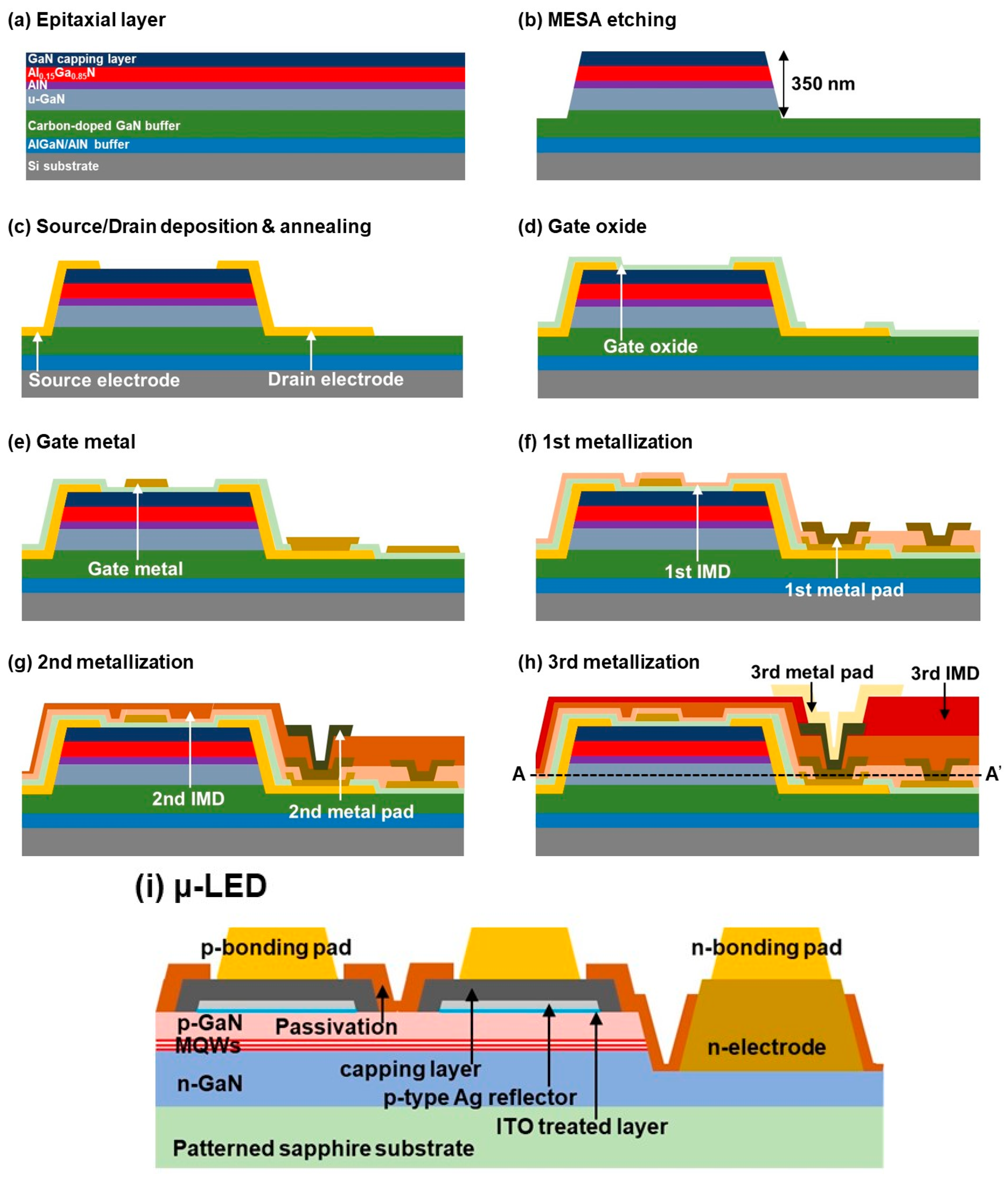
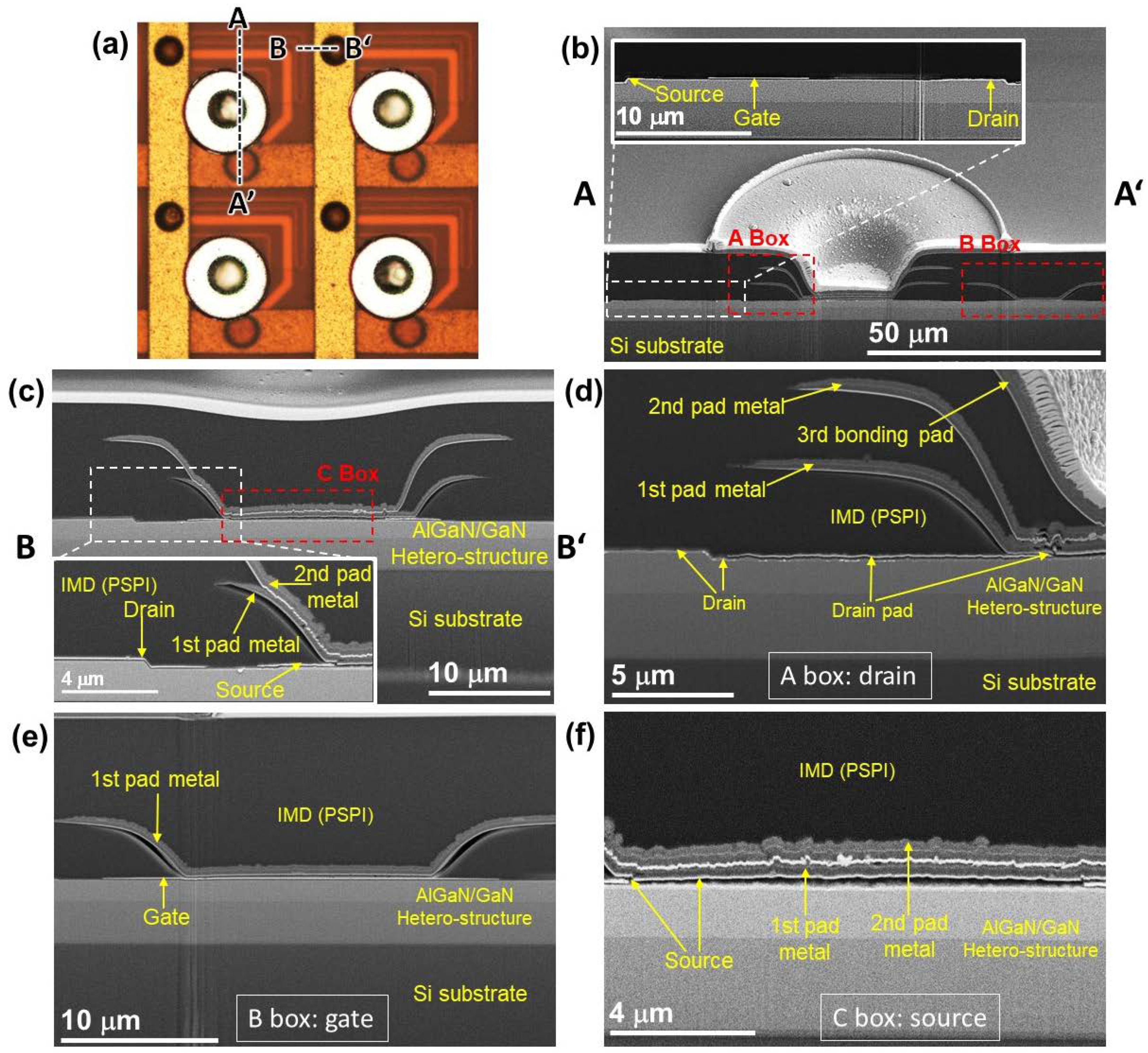

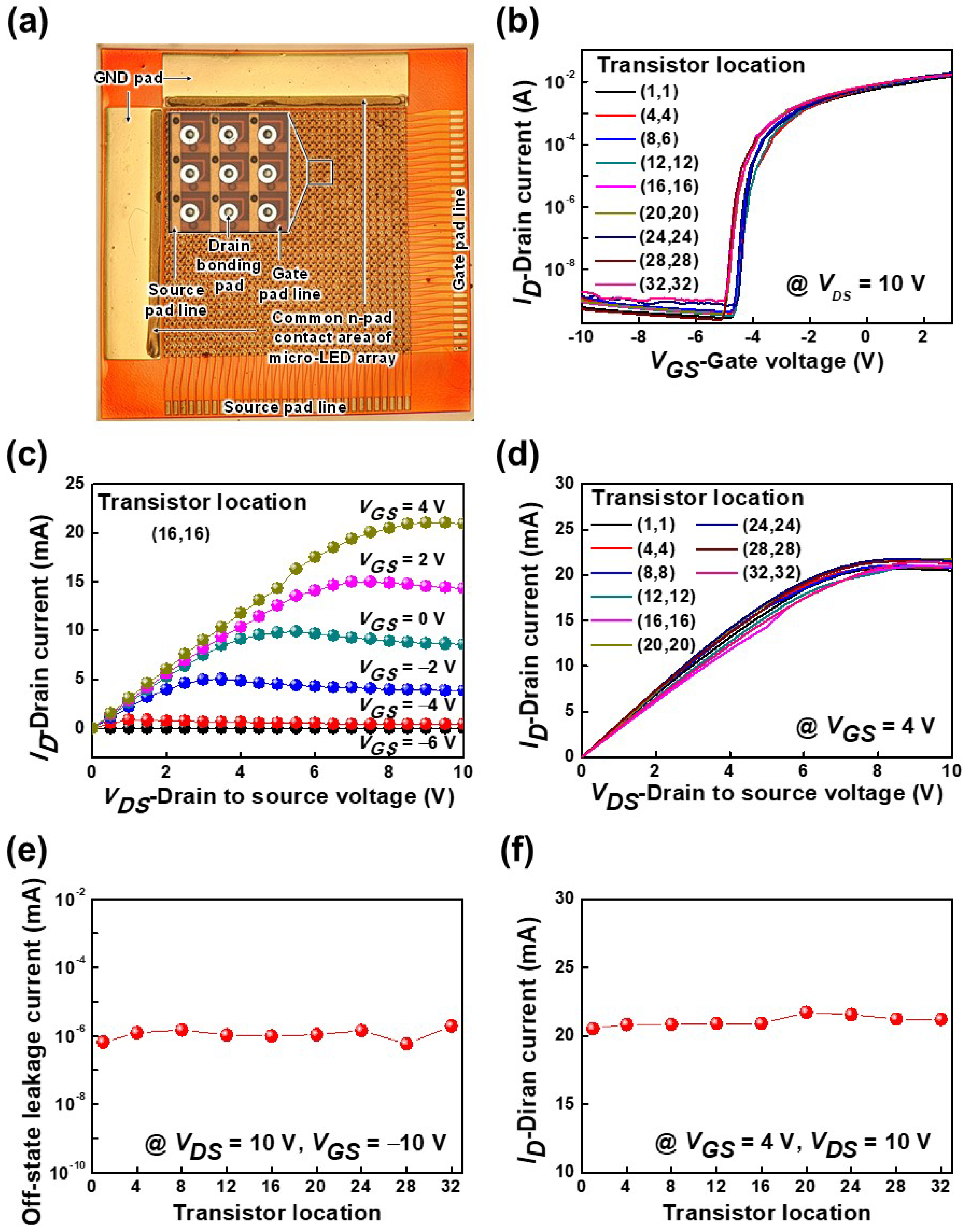
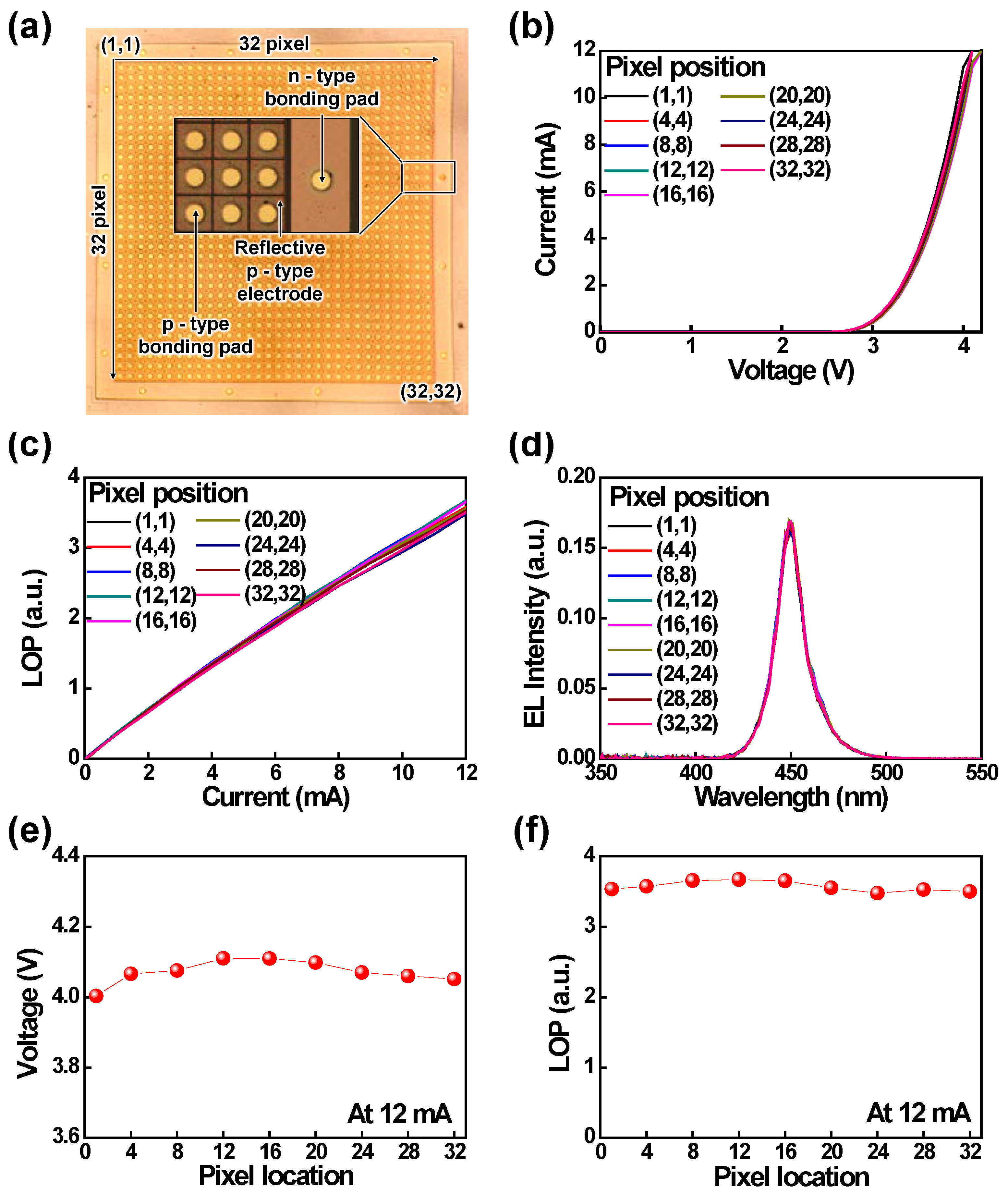
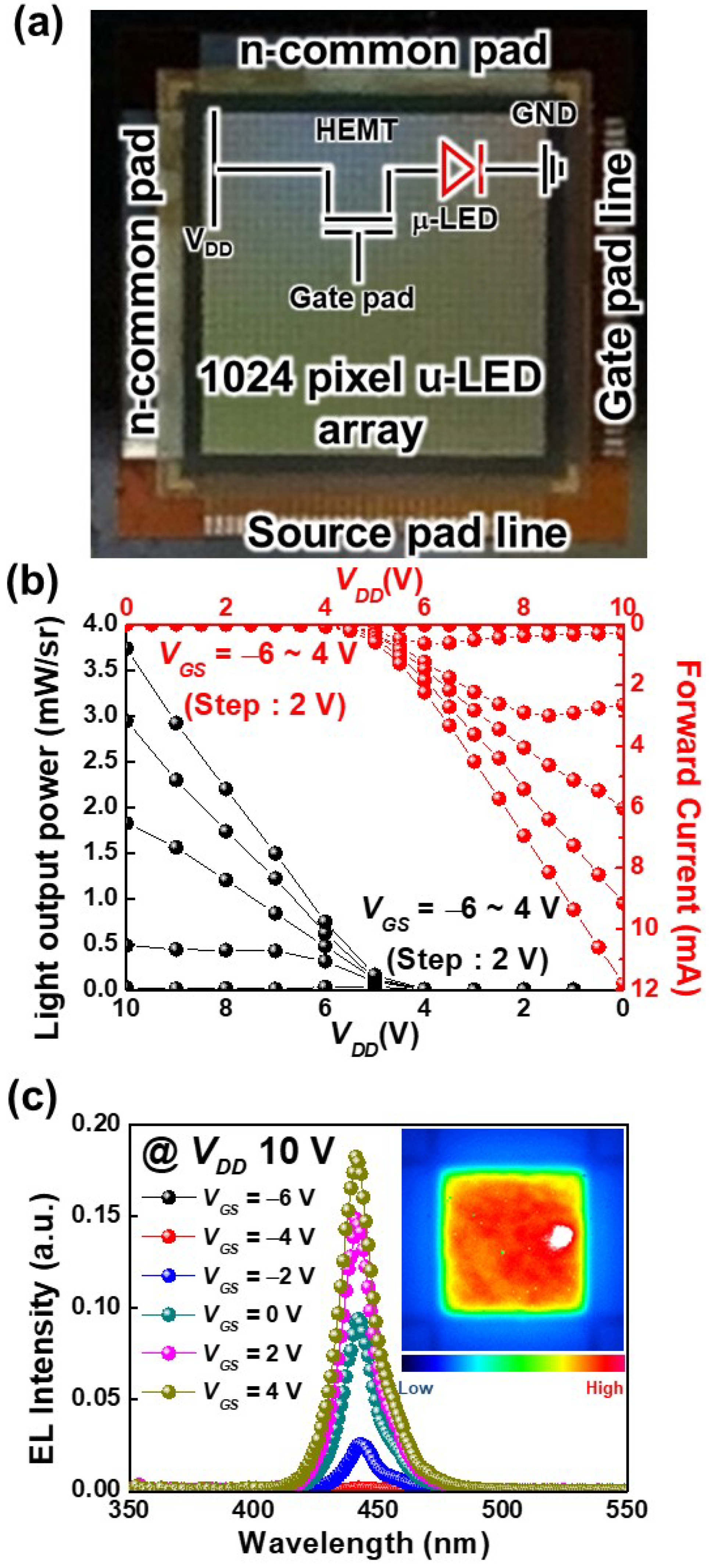
Publisher’s Note: MDPI stays neutral with regard to jurisdictional claims in published maps and institutional affiliations. |
© 2021 by the authors. Licensee MDPI, Basel, Switzerland. This article is an open access article distributed under the terms and conditions of the Creative Commons Attribution (CC BY) license (https://creativecommons.org/licenses/by/4.0/).
Share and Cite
Kim, T.K.; Islam, A.B.M.H.; Cha, Y.-J.; Kwak, J.S. 32 × 32 Pixelated High-Power Flip-Chip Blue Micro-LED-on-HFET Arrays for Submarine Optical Communication. Nanomaterials 2021, 11, 3045. https://doi.org/10.3390/nano11113045
Kim TK, Islam ABMH, Cha Y-J, Kwak JS. 32 × 32 Pixelated High-Power Flip-Chip Blue Micro-LED-on-HFET Arrays for Submarine Optical Communication. Nanomaterials. 2021; 11(11):3045. https://doi.org/10.3390/nano11113045
Chicago/Turabian StyleKim, Tae Kyoung, Abu Bashar Mohammad Hamidul Islam, Yu-Jung Cha, and Joon Seop Kwak. 2021. "32 × 32 Pixelated High-Power Flip-Chip Blue Micro-LED-on-HFET Arrays for Submarine Optical Communication" Nanomaterials 11, no. 11: 3045. https://doi.org/10.3390/nano11113045
APA StyleKim, T. K., Islam, A. B. M. H., Cha, Y.-J., & Kwak, J. S. (2021). 32 × 32 Pixelated High-Power Flip-Chip Blue Micro-LED-on-HFET Arrays for Submarine Optical Communication. Nanomaterials, 11(11), 3045. https://doi.org/10.3390/nano11113045






